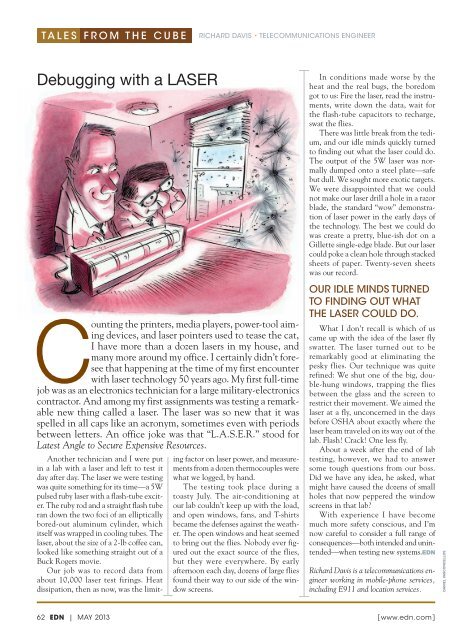201305.pdf 43279KB May 08 2013 11:07:04 PM
201305.pdf 43279KB May 08 2013 11:07:04 PM
201305.pdf 43279KB May 08 2013 11:07:04 PM
Create successful ePaper yourself
Turn your PDF publications into a flip-book with our unique Google optimized e-Paper software.
Tales from The CuberiChard davis • TeleCommuniCaTions engineerDebugging with a LASERCounting the printers, media players, power-tool aimingdevices, and laser pointers used to tease the cat,I have more than a dozen lasers in my house, andmany more around my office. I certainly didn’t foreseethat happening at the time of my first encounterwith laser technology 50 years ago. My first full-timejob was as an electronics technician for a large military-electronicscontractor. And among my first assignments was testing a remarkablenew thing called a laser. The laser was so new that it wasspelled in all caps like an acronym, sometimes even with periodsbetween letters. An office joke was that “L.A.S.E.R.” stood forLatest Angle to Secure Expensive Resources.Another technician and I were putin a lab with a laser and left to test itday after day. The laser we were testingwas quite something for its time—a 5Wpulsed ruby laser with a flash-tube exciter.The ruby rod and a straight flash tuberan down the two foci of an ellipticallybored-out aluminum cylinder, whichitself was wrapped in cooling tubes. Thelaser, about the size of a 2-lb coffee can,looked like something straight out of aBuck Rogers movie.Our job was to record data fromabout 10,000 laser test firings. Heatdissipation, then as now, was the limitingfactor on laser power, and measurementsfrom a dozen thermocouples werewhat we logged, by hand.The testing took place during atoasty July. The air-conditioning atour lab couldn’t keep up with the load,and open windows, fans, and T-shirtsbecame the defenses against the weather.The open windows and heat seemedto bring out the flies. Nobody ever figuredout the exact source of the flies,but they were everywhere. By earlyafternoon each day, dozens of large fliesfound their way to our side of the windowscreens.In conditions made worse by theheat and the real bugs, the boredomgot to us: Fire the laser, read the instruments,write down the data, wait forthe flash-tube capacitors to recharge,swat the flies.There was little break from the tedium,and our idle minds quickly turnedto finding out what the laser could do.The output of the 5W laser was normallydumped onto a steel plate—safebut dull. We sought more exotic targets.We were disappointed that we couldnot make our laser drill a hole in a razorblade, the standard “wow” demonstrationof laser power in the early days ofthe technology. The best we could dowas create a pretty, blue-ish dot on aGillette single-edge blade. But our lasercould poke a clean hole through stackedsheets of paper. Twenty-seven sheetswas our record.our idle minds TurnedTo finding ouT whaTThe laser Could do.What I don’t recall is which of uscame up with the idea of the laser flyswatter. The laser turned out to beremarkably good at eliminating thepesky flies. Our technique was quiterefined: We shut one of the big, double-hungwindows, trapping the fliesbetween the glass and the screen torestrict their movement. We aimed thelaser at a fly, unconcerned in the daysbefore OSHA about exactly where thelaser beam traveled on its way out of thelab. Flash! Crack! One less fly.About a week after the end of labtesting, however, we had to answersome tough questions from our boss.Did we have any idea, he asked, whatmight have caused the dozens of smallholes that now peppered the windowscreens in that lab?With experience I have becomemuch more safety conscious, and I’mnow careful to consider a full range ofconsequences—both intended and unintended—whentesting new systems.EDNRichard Davis is a telecommunications engineerworking in mobile-phone services,including E9<strong>11</strong> and location services.Daniel Vasconcellos62 EDN | MAY <strong>2013</strong>[ www.edn.com]






![[270].pdf 37407KB Sep 02 2010 09:55:57 AM - ElectronicsAndBooks](https://img.yumpu.com/50350834/1/185x260/270pdf-37407kb-sep-02-2010-095557-am-electronicsandbooks.jpg?quality=85)
![draaien, A Viruly 1935 OCR c20130324 [320]. - ElectronicsAndBooks](https://img.yumpu.com/49957773/1/190x252/draaien-a-viruly-1935-ocr-c20130324-320-electronicsandbooks.jpg?quality=85)



![20051110 c20051031 [105].pdf 35001KB Feb 18 2009 08:46:32 PM](https://img.yumpu.com/48687202/1/190x253/20051110-c20051031-105pdf-35001kb-feb-18-2009-084632-pm.jpg?quality=85)




